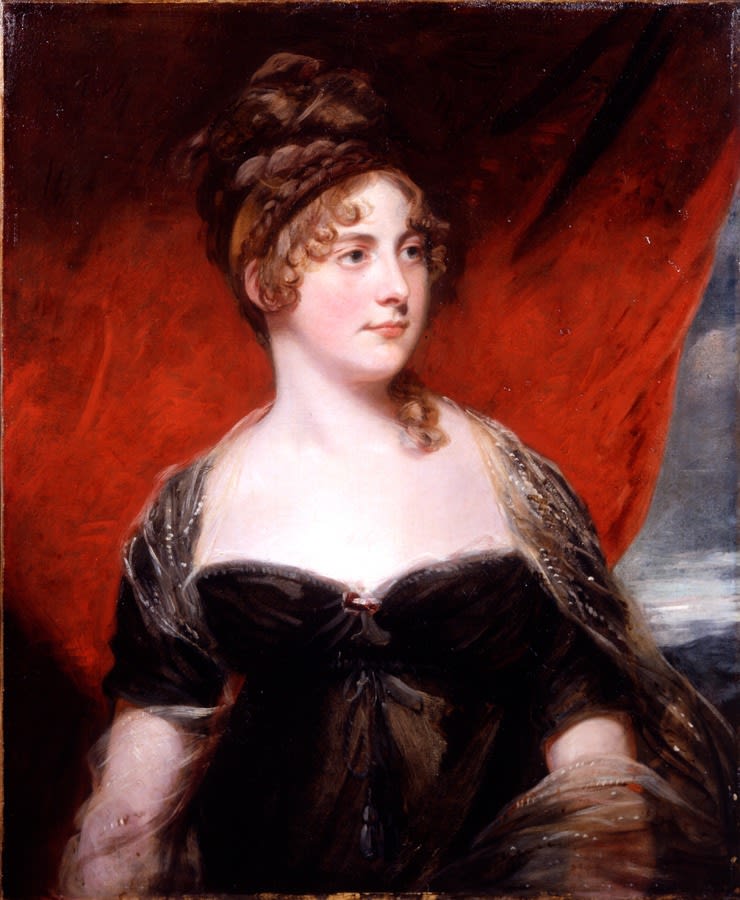
John Hoppner RA
Portrait of Anne Garbett Lady Romilly, c. 1800
Oil on canvas
30 x 25 in. (76.2 x 63.5 cm)
Philip Mould & Co.
To view all current artworks for sale visit philipmould.com The young sitter in this portrait, her complexion shown off to great advantage by the contrast with her fashionable dark...
To view all current artworks for sale visit philipmould.com
The young sitter in this portrait, her complexion shown off to great advantage by the contrast with her fashionable dark dress, was the daughter of Francis Garbett of Knill Court in Herefordshire. On January 3rd, 1798, the date at which this portrait may have been painted, she married Sir Samuel Romilly MP (1757-1818), who served as Solicitor General from 1806 to 1807 in the Addington-Fox-Grenville coalition government.
Romilly was distinguished in his time as a law reformer and a philanthropist. Descended from the Huguenot émigré Etienne Romilly, he studied widely in the law of England and France, and, despite reservations at its extremity, felt as late as 1798 that the revolutionary law and government of France might hold much to benefit the English system. He had long been a believer in reform, and in the abolition of the slave trade. These political leanings led him into the society of such men as William Wilberforce, Jeremy Bentham and William Petty 1st Marquess of Lansdowne.
It was at Bowood, the seat of the last, that he was introduced to Whig society, and to his Anne Garbett, his future wife, whose father had been Lansdowne’s secretary. Feelings between the couple were so strong that an engagement was announced after a courtship of only ten days. Although the couple were happy for twenty years, Romilly had long been concerned for his mental health, and tendency towards depression that he had recognised in himself at least since the 1780s. This fear of ‘madness’ - in his own all-encompassing self-diagnosis1- led him to amend his will in October 1818 in case of his mental collapse. He had begun to realise that he was less and less able to cope with the strain of his wife’s illness, which had begun in the spring of that year, and when she died on October 29th he committed suicide by cutting his throat some four days later.
Sir Samuel and Lady Romilly had six sons and a daughter. The second son John (1802 – 1874) followed in his father’s political and legal career, serving as Solicitor General and then as Master of the Rolls, for which he was created Lord Romilly in January 1866.
1. Dictionary of National Biography.
The young sitter in this portrait, her complexion shown off to great advantage by the contrast with her fashionable dark dress, was the daughter of Francis Garbett of Knill Court in Herefordshire. On January 3rd, 1798, the date at which this portrait may have been painted, she married Sir Samuel Romilly MP (1757-1818), who served as Solicitor General from 1806 to 1807 in the Addington-Fox-Grenville coalition government.
Romilly was distinguished in his time as a law reformer and a philanthropist. Descended from the Huguenot émigré Etienne Romilly, he studied widely in the law of England and France, and, despite reservations at its extremity, felt as late as 1798 that the revolutionary law and government of France might hold much to benefit the English system. He had long been a believer in reform, and in the abolition of the slave trade. These political leanings led him into the society of such men as William Wilberforce, Jeremy Bentham and William Petty 1st Marquess of Lansdowne.
It was at Bowood, the seat of the last, that he was introduced to Whig society, and to his Anne Garbett, his future wife, whose father had been Lansdowne’s secretary. Feelings between the couple were so strong that an engagement was announced after a courtship of only ten days. Although the couple were happy for twenty years, Romilly had long been concerned for his mental health, and tendency towards depression that he had recognised in himself at least since the 1780s. This fear of ‘madness’ - in his own all-encompassing self-diagnosis1- led him to amend his will in October 1818 in case of his mental collapse. He had begun to realise that he was less and less able to cope with the strain of his wife’s illness, which had begun in the spring of that year, and when she died on October 29th he committed suicide by cutting his throat some four days later.
Sir Samuel and Lady Romilly had six sons and a daughter. The second son John (1802 – 1874) followed in his father’s political and legal career, serving as Solicitor General and then as Master of the Rolls, for which he was created Lord Romilly in January 1866.
1. Dictionary of National Biography.
Provenance
By family descent